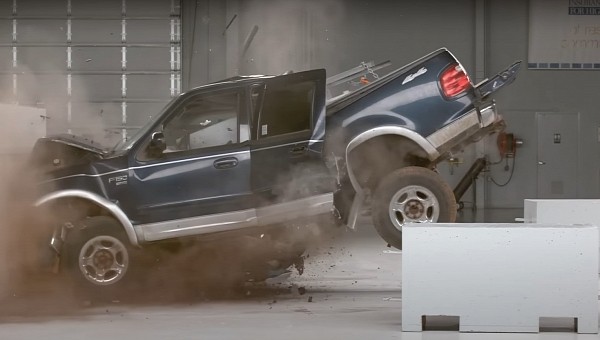The Insurance Institute for Highway Safety (IIHS) has been around since 1959 and plays a significant role in evaluating the safety of vehicles with the aim of reducing injuries, deaths, and property damage by conducting crash tests.
As the automotive world transitions to electric vehicles that are much heavier than vehicles of the past because of their batteries, the IIHS has been forced to test its equipment to make sure it will meet the demands of heavier vehicle testing.
At the core of the testing process is the propulsion system they use to tow vehicles toward a crash barrier. Since these vehicles are not being driven into the barrier, the organization needed to be sure that the system at its Vehicle Research Center would be able to handle the extra weight. Leading up to this test, the heaviest vehicle the IIHS tested was the 5,720-pound (2,595 kg) Audi e-Tron.
To test the system, they took a couple of older pickup trucks and loaded them with steel plates and concrete blocks to bring their mass up to about 9,500 lbs. (4,309 kg), significantly more than they are accustomed to testing.
The system is run on a track on the floor of the facility and must be able to bring vehicles up to speed smoothly and maintain that speed until the vehicle hits the crash barrier.
An older Ford F-150 was used for the test in the video below and was brought up to 40 mph (64.37 kph). All frontal crash tests, as well as moderate overlap, and small overlap crashes on the left and right sides are done at a maximum speed of 40 mph (64.37 kph).
At 600 feet (182.88 meters) in length, the system successfully brought the 9,500-pound (4,309 kg) truck up to the designated speed and maintained that speed until the truck came in contact with the crash barrier.
It appears the organization is prepared with its existing equipment to continue to provide critical crash test data to consumers, policymakers, and safety professionals in and around the automotive industry.
At the core of the testing process is the propulsion system they use to tow vehicles toward a crash barrier. Since these vehicles are not being driven into the barrier, the organization needed to be sure that the system at its Vehicle Research Center would be able to handle the extra weight. Leading up to this test, the heaviest vehicle the IIHS tested was the 5,720-pound (2,595 kg) Audi e-Tron.
To test the system, they took a couple of older pickup trucks and loaded them with steel plates and concrete blocks to bring their mass up to about 9,500 lbs. (4,309 kg), significantly more than they are accustomed to testing.
The system is run on a track on the floor of the facility and must be able to bring vehicles up to speed smoothly and maintain that speed until the vehicle hits the crash barrier.
An older Ford F-150 was used for the test in the video below and was brought up to 40 mph (64.37 kph). All frontal crash tests, as well as moderate overlap, and small overlap crashes on the left and right sides are done at a maximum speed of 40 mph (64.37 kph).
At 600 feet (182.88 meters) in length, the system successfully brought the 9,500-pound (4,309 kg) truck up to the designated speed and maintained that speed until the truck came in contact with the crash barrier.
It appears the organization is prepared with its existing equipment to continue to provide critical crash test data to consumers, policymakers, and safety professionals in and around the automotive industry.
Watch ???? | The IIHS crash propulsion system is still pulling it's weight.
— IIHS (@IIHS_autosafety) December 3, 2022
Our crashworthiness team recently put it to the test ?? https://t.co/yfg36ijuXL






